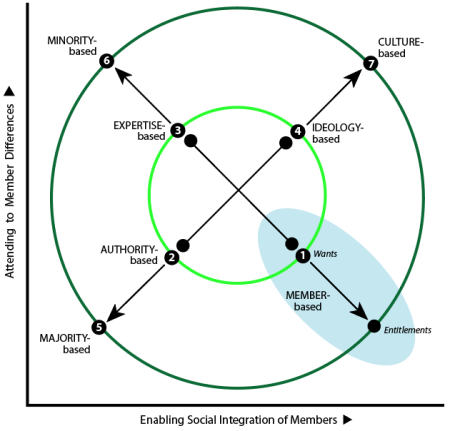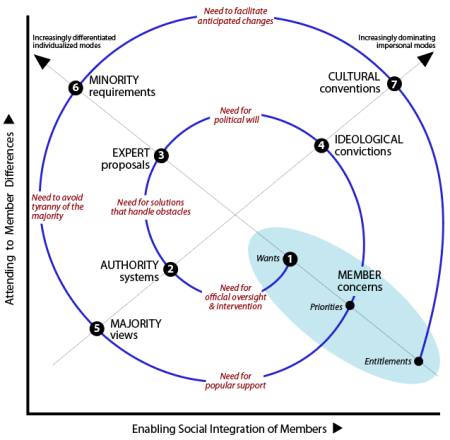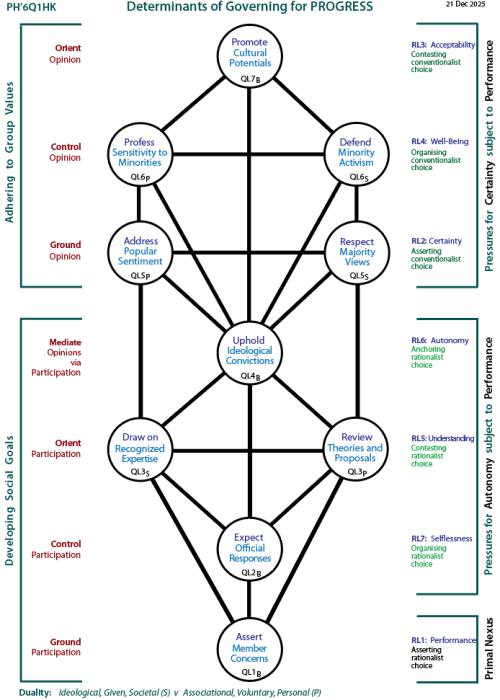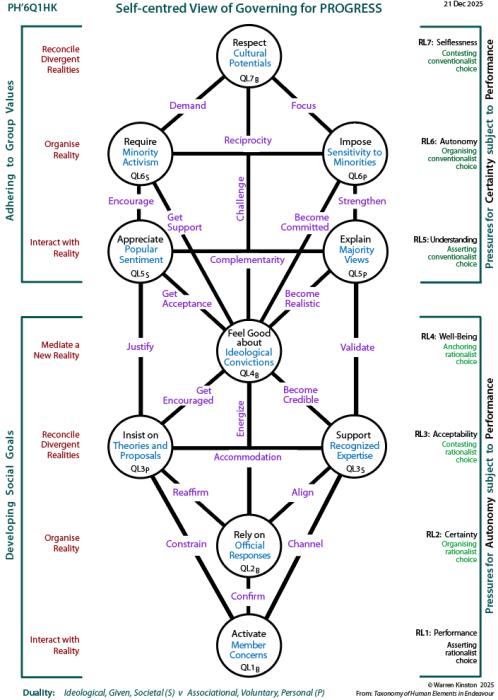Purpose Domain:
Arenas for Governing (PH'6Q•)
NOTE: THIS PAGE IS A WORK IN PROGRESS
Overview
The are about hoping for benefits in society.
The are each presented briefly here
The pairing of these Arenas is explained here.
The Tree of the 7 Arenas is proposed here.
In this webpage, after providing a summary Table of the 7 Arenas, there will be further Tables and diagrams related to each of the Arenas, specifically:
a) the Types in the Arena
b) the Spiral of Growth in the Arena
c) the Tree of the Arena
All formulations are summary propositions. Being at an early stage of drafting, they need correction, expansion, refinement and improvement.
is about handling of benefits that potentially emerge naturally within large organized societies. Labels to help grasp each of the Arenas are shown in the Table below.
| PH'6 | Label for Benefit Constituent Types |
Typology PH'6Q•t |
Spiral PH'6Q•C |
Hierarchy PH'6Q•H |
Tree PH'6Q•HK |
Struct Hier PH'6Q•sH |
Str Hier Tree PH'6Q•sHK |
|---|---|---|---|---|---|---|---|
| Hope within a Governing Arena |
Ways to Get Benefit in Society | Strengthening Governing | Levels in the Governing Arena | Dynamic Determinants | Context of the Arena | Socio-emotional Engagement | |
| -Q7 | Liberty
(T7) guided by (T1) |
... to experience freedom in society | Strengthening via awareness |
... of | ... of governing for the liberty of each person. |
n/k | n/k |
| -Q6 | Morality
(T6) guided by (T7) |
... to live virtuously | Strengthening via adjustment |
... of | ... of governing for morality amongst all. | n/k | n/k |
| -Q5 | Security
(T5) guided by (T6) |
... to allocate common goods | Strengthening via social presence |
... of | ... of governing for security within society. | n/k | n/k |
| -Q4 | Prosperity
(T4) guided by (T5) |
... to interact for benefit | Strengthening development of social status |
... of | ... of governing for prosperity in a community |
n/k | n/k |
| -Q3 | Harmony
(T3) guided by (T4) |
... to join a social group seek group membership |
Strengthening via bonding |
... of a | ... of governing for harmony amongst individuals |
n/k | n/k |
| -Q2 | Leadership
(T2) guided by (T3) |
... to recognize current values | Strengthening via self-confirmation |
... of | ... of governing for leadership given diversity |
n/k | n/k |
| -Q1 | Progress
(T1) guided by (T2) |
... to choose social goals | Strengthening capability for social change |
... of | ... of governing for progress in line with public sentiment. |
n/k | n/k |
Q1: Progress
The condition of any society is such that its members have wants and needs that can be best met, sometimes only met, if society changes in some way. When change results in these wants and needs being more completely met, it is regarded as social progress.
Social progress is one of the benefits that all hope to get from living in a society and accepting being governed.
| # | Ways (t) to Choose Social Goals TET |
Modes/Stages (μ/Φ) in Strengthening Capability for Social Change Spiral |
Hierarchy (L) for Social Progress Tree |
|---|---|---|---|
| 7 | Culture-based Conventional choices |
Cultural conventions | The Culture |
| 6 | Minority-based Diversity choices |
Minority requirements | Minorities |
| 5 | Majority-based Popular choices |
Majority views | The Majority |
| 4 | Ideology-based Political choices |
Ideological convictions | Ideology |
| 3 | Expertise-based Rational choices |
Expert proposals | Expertise |
| 2 | Authority-based Official choices |
Authority systems | Authority |
| 1 | Member-based Personal choices |
Member concerns | Membership |
Q1t: Ways to Define Social Goals
| T | Way to Choose Social Goals |
Source | Quality | Oscillating Duality | Property 1 | Limitation & its Overcoming |
Effect of Absence |
|---|---|---|---|---|---|---|---|
| 7 | Culture-based choices | Traditions, customs, historical conditioning. | Conventional | ||||
| 6 | Minority-based choices | Diverse | |||||
| 5 | Majority-based choices | Popular | |||||
| 4 | Ideology-based choices | Politicians and social theoreticians | Political | ||||
| 3 | Expertise-based choices | Academics and recognized experts/ | Rational | ||||
| 2 | Authority-based choices | Bureaucratic structures, systems and personnel. | Official | ||||
| 1 | Member-based choices | Members of the society | Personal |

The at any point in time can be plotted high or low in relation to the enabling of social integration of members(X-axis) and the attention given to member differences within society (Y-axis).
As usual, the ways fall into quadrants. Those in the lower two quadrants generate spontaneous acceptance, while those in the upper two quadrants are require reflection and more deliberate acceptance. Ways in the right two quadrants are highly visible or easily recognized, while those in the left two quadrants have much less visibility and call for discernment. Ways in diametrically opposite quadrants engender a degree of antagonism: LR choices are widespread, while UL choices are focused; LL choices are pragmatic and concrete, while UR choices are conceptual or theoretical.
The inner circle contains ways that choose goals that deserve pursuit as a matter of principle, and are developed by relatively small groups.
The outer circle contains ways that choose goals that serve self-interest and emerge from the status quo, and reflect larger groups in society.
The two circles fuse in which change from being a matter of principle to being an entitlement.
Choices debatable and the arrows indicate preferences for validation and confirmation of the value of the choice i.e. official choices (t2) are confirmed by the majority (t5), ideological choices (t4) look to the culture (t7) for validation, expert choices (t3) will be appreciated and confirmed by a minority (t5), and a member's want (t1) becomes validated when it is an entitlement.
Q1C: Stages in Strengthening Capability for Social Change
In this framework, the , having been plotted, are viewed as .

These modes comprise distinctive sets of principles and values for pressing for chosen goals. Together they spell out what is required to be capable of social change.
Progressive change commences with , while recognizing that. on its own, this is meaningless without development. So the Spiral is an effortful process in which the values of each Mode (μ) cumulate to form a series of Stages (Φ). Development can stop at any Stage if the is judged sufficient.
Cycle-1 modes use Stage-1 to enable to get recognition in society: initially by engaging in turning to , then by , and finally by . At the end of this Cycle, the will have become widely recognized as important and deserving attention.
In Cycle-2, the last three modes progressively address self-interest within the status quo, initially by , then by taking into account , and finally by .
depends on moving from the simple to the emergence of . and ultimately to recognizing .
Drivers for the evolutionary progression through these modes appear to be: (a) controversy over addressing member wants, (b) need to increase pressure beyond what is possible in the present Stage, (c) pressure from internal or external sources: economic, political environmental, and (d) limitations, degeneration or dysfunction of the current mode.
Q1HK: Determinants of Progress in Society
As usual, a Tree can be created from the Q-typology (equivalent to the essence of each of the 7 modes) and this provides for dynamics between the .
The dynamic duality to be applied is associational/voluntary/personal v ideological/given/social.
The internal duality suggested is adhering to group values v developing social goals.
The psychosocial pressures are autonomy as the underpinning force derived from the domain, and not shown in the diagram; and then performance based on the Q1 position, and finally autonomy (from ) and certainty (from ).
The requisite and self-interested Trees are shown below.
Better viewing: Use browser zoom if needed.

|

|
Q1sH & Q1sHK: Undetermined
Q2: Leadership
| # | Ways (t) to Recognize Current Values TET |
Modes/Stages (μ/Φ) in ___________ Spiral |
Hierarchy (L) for __________ Tree |
|---|---|---|---|
| 7 | Leadership-driven | ||
| 6 | Change-driven | ||
| 5 | Situation-driven | ||
| 4 | Communication-driven | ||
| 3 | Interest-driven | ||
| 2 | Custom-driven | ||
| 1 | Popular opinion-driven |
Q2t: Ways to Recognize Current Values
Q2C: Stages in Strengthening
Q2HK: Determinants of
Q2sH & Q2sHK: Undetermined
Q3: Harmony
| # | Ways (t) to Reconcile Diversity TET |
Modes/Stages (μ/Φ) in ________ Spiral |
Hierarchy (L) for ______ Tree |
|---|---|---|---|
| 7 | Merit-oriented | ||
| 6 | Authority-oriented | ||
| 5 | Individual-oriented | ||
| 4 | Status-oriented | ||
| 3 | Politics-oriented | ||
| 2 | Faction-oriented | ||
| 1 | Improvement-oriented |
Q3t: Ways to Reconcile Diversity
Q3C: Stages in Strengthening
Q3HK: Determinants of
Q3sH & Q3sHK: Undetermined
Q4: Prosperity
| # | Ways (t) to Interact for Benefit TET |
Modes/Stages (μ/Φ) in ___________ Spiral |
Hierarchy (L) for ______ Tree |
|---|---|---|---|
| 7 |
Reality-centred |
||
| 6 | Perspective-centred | ||
| 5 | Kinship-centred Family-choice |
||
| 4 | Community-centred Fair choice |
||
| 3 | Cause-centred Meaningful choice |
||
| 2 | Power-centred Status choice |
||
| 1 | Market-centred Commercial choice |
Q4t: Ways to Interact for Benefit
Q4C: Stages in Strengthening
Q4HK: Determinants of
Q4sH & Q4sHK: Undetermined
Q5: Security
| # | Ways (t) to Allocate Common Goods TET |
Modes/Stages (μ/Φ) in _____ Spiral |
Hierarchy (L) for ____ Tree |
|---|---|---|---|
| 7 | Justice-driven | ||
| 5 | Duty-driven | ||
| 4 | Entitlement-driven | ||
| 6 | Development-driven | ||
| 3 | Loyalty-driven | ||
| 2 | Resource-driven | ||
| 1 | Needs-driven |
Q5t: Ways to Allocate Common Goods
Q5C: Stages in Strengthening
Q5HK: Determinants of
Q5sH & Q5sHK: Undetermined
Q6: Morality
| # | Ways (t) to Live Virtuously TET |
Modes/Stages (μ/Φ) in _______ Spiral |
Hierarchy (L) for __________ Tree |
|---|---|---|---|
| 7 | Time-centred | ||
| 6 | Identity-centred | ||
| 5 | doctrine-centred | ||
| 4 | Conformity-centred | ||
| 3 | Autonomy-centred | ||
| 2 | Purpose-centred | ||
| 1 | Duty-centred |
Q6t: Ways to Live Virtuously
Q6C: Stages in Strengthening
Q6HK: Determinants of
Q6sH & Q6sHK: Undetermined
Q7: Liberty
| # | Ways (t) to Experience Freedom TET |
Modes/Stages (μ/Φ) in ___________ Spiral |
Hierarchy (L) for _______ Tree |
|---|---|---|---|
| 7 | Destiny-based | ||
| 6 | Plan-based | ||
| 5 | Desire-based | ||
| 4 | Integrity-based | ||
| 3 | Opportunity-based | ||
| 2 | Obligation-based | ||
| 1 | Spirit-based |
Q7t: Ways to Experience Freedom in Society
Q7C: Stages in Strengthening
Q7HK: Determinants of
Q7sH & Q7sHK: Undetermined
Originally posted: 30-Nov-2024